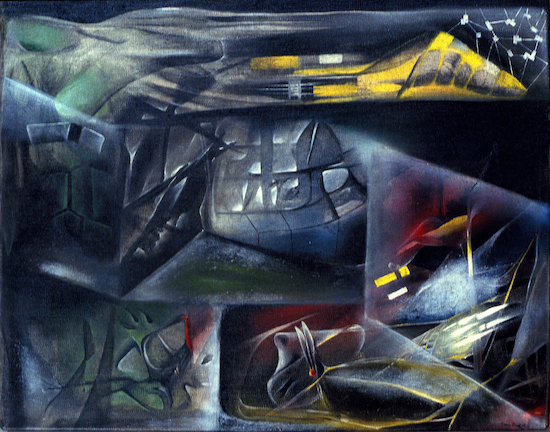Artist Birthday: Jimmy Ernst
Jimmy Ernst was the son of pioneering German Surrealist artist Max Ernst. In the late 1940s he emerged as a major force in American Abstract Expressionism.
Artist Birthday for 20 June: Jimmy Ernst (1920–1984, United States, born Germany)
The art of Jimmy Ernst began in the 1930s with Surrealism and led him eventually to total abstraction.
 |
| Jimmy Ernst, Abstraction, 1945. Oil on canvas, 30.4 x 38.1 cm. Courtesy of the Butler Institute of American Art, Youngstown, Ohio. © 2025 Jimmy Ernst / Artists Rights Society (ARS), New York. (BIAA-238etars) |
Ernst's early canvases were tinged with Surrealism, and his first solo show (1942) featured organic abstractions. His interpretations of jazz themes during the 1940s, in which discrete color areas were used to approximate syncopation and rhythm, yielded in the 1950s to experiments with line that determined his future directions. He became a member of the Irascibles, mostly Abstract Expressionists who protested the Metropolitan Museum of Art's refusal to accept abstract art in exhibitions.
In his mature work, Ernst used complex interlocking webs of line to manipulate pictorial space and to create architectonic structures. Always abstract, his later paintings possess the spatial quality of panoramic cityscapes. In the 1960s and 1970s he returned to figuration producing paintings that often incorporated Native American symbols he probably saw while living in Arizona. His late paintings were landscapes that echoed the linear precision of his early abstractions.
Surrealism was a movement that evolved during the 1920s in Europe out of Dada’s rejection of logic and reason in art. Surrealism sought to overthrow rationalism in art in favor of pure, spontaneous, subconscious creation. The Surrealist artists’ styles varied widely from Photorealism to organic and biomorphic abstract imagery.
The first United States exhibition of Surrealism was in Hartford, Connecticut, in 1931, followed by another in New York at the Julien Levy Gallery in 1936. Levy wrote an early study of the movement in his 1936 book Surrealism. Along with the Museum of Modern Art’s 1936 exhibition Fantastic Art, Dada, and Surrealism, the movement was cemented as a major force in modern art for Americans.
When major Surrealist artists migrated to New York before World War II (1939–1945)—Max Ernest (1891–1976), Marcel Duchamp (1887–1968), and Yves Tanguy (1900–1955) to name a few—Surrealism established not only a foundation for Abstract Expressionism, but also brought the Surrealist style solidly into the American modernist art scene.
Ernst was born Hans-Ulrich Ernst in Cologne, Germany, son of Surrealist painter Max Ernst, and Jewish art historian Dr Luise Straus (1893–1945, killed at Auschwitz concentration camp). After his parents divorced in 1922, Max moved to Paris. Jimmy met all of the celebrated Surrealists when he visited his father, including Salvador Dali (1904–1989), Man Ray (1890–1976), Joan Miró (1893–1983), and Yves Tanguy (1900–1955).
In 1933, Jimmy immigrated to the United States to avoid the Nazis, successfully bringing his father over in 1941. In New York, he cultivated his painting career, which had started after he saw Pablo Picasso's (1881–1973) Guernica in Paris in 1933. His early work was explicitly Surreal, often resembling his father's, and built on the foundation of Surrealist automatism (painting without planning or thought). He turned to Abstract Expressionism in the late 1940s.

Comments